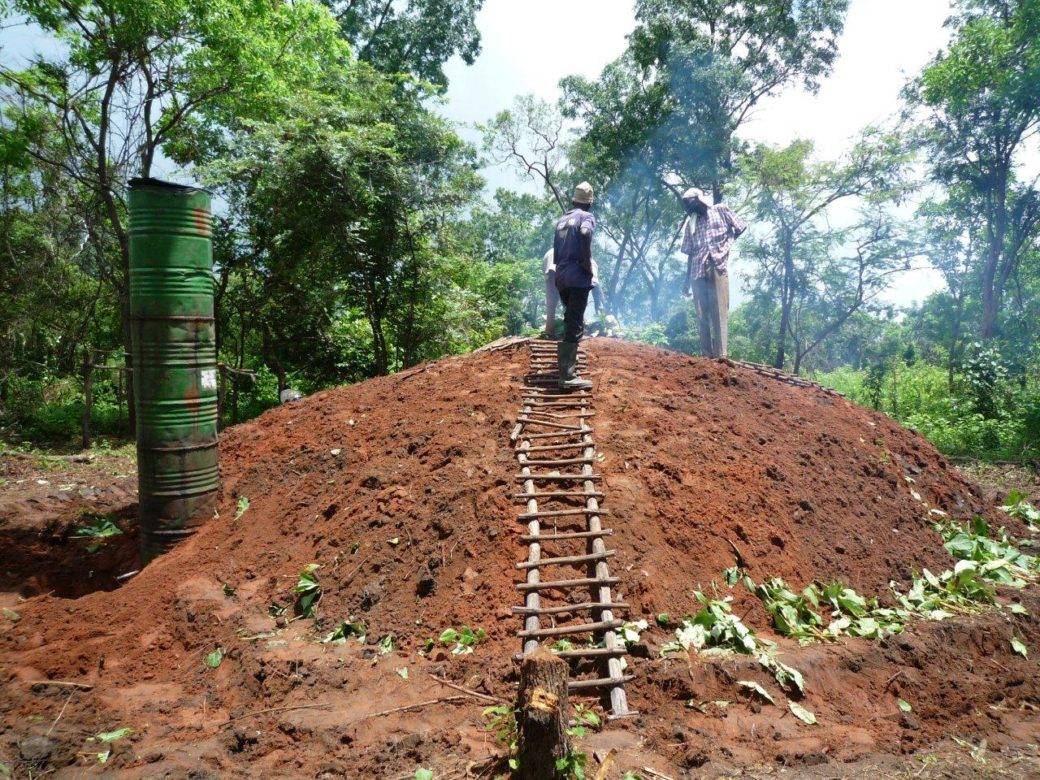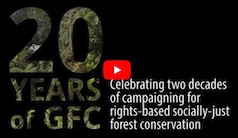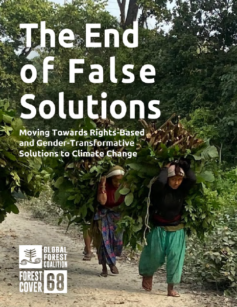International climate and forest-related finance has always been one of the stickiest issues in multilateral efforts to mitigate and adapt to the impacts of climate change, and the urgency of action means that it must be properly monitored and scrutinized. The Global Environment Facility (GEF) is a case in point, and the German government is one of the main contributors to this multi-lateral climate finance mechanism.
Two new reports look at projects that Germany has recently contributed to directly or indirectly and highlight the problems with directing climate finance towards clean cookstove and charcoal supply-chain projects. The first shows how finance for the charcoal supply chain through a GEF project in Uganda has promoted tree plantations at the expense of forest restoration with highly questionable climate benefits (download the full case study). The second looks at three projects involving improved biomass cookstoves (two are GEF projects and a third is led by Germany’s Federal Ministry of Economic Cooperation and Development/BMZ), and how effective they are at minimizing indoor air pollution and its adverse health impacts on women and children (download the full report). In both of these cases, there is serious doubt that the millions spent in project funding has actually helped to reduce carbon emissions, a fundamental aim of climate finance.
GEF’s Green Charcoal Project in Uganda plants over 6 million eucalyptus trees
The Green Charcoal Project aimed to improve the efficiency of charcoal production and to promote sustainable land management practices where wood is sourced from. It received funding through the Global Environment Facility as well as co-financing from GIZ (a German development agency) and a number of other sources. The project was implemented by UNDP and the Government of Uganda in four areas that have high deforestation rates largely due to charcoal production. In addition to distributing and training communities to use improved charcoal production methods, the project focused on developing “sustainably managed woodlots” in order to reduce pressures on remaining forests.
Despite being approved on the basis that landowners would be supported to plant a number of indigenous tree species that are used locally for charcoal production, instead at least 90% of the 6.8 million trees planted were non-native, fast-growing eucalyptus, covering 6,200 hectares of land. By the project’s own admission, there is no guarantee that any of the trees planted will actually be used for charcoal production given that native trees found in surrounding forests are more suitable, landowners are under no obligation to sell to charcoal producers and, most significantly, the project ended before the first harvest of wood was made, making any monitoring impossible.
An on-the-ground investigation into the project found that landowners first cleared their land completely before planting the eucalyptus trees, which meant the removal of native grasslands and shrub and tree species. A prolonged drought during the first planting meant that the survival rate of the trees was as low as 40% in some areas, leaving the land barer than before and susceptible to erosion when rain did eventually come. There is now less vegetation cover and poorer soils in the districts that the investigators visited, and communities have continued to source wood from existing forests for charcoal production.
Communities also report that eucalyptus trees aren’t as suitable for charcoal-making as endemic tree species. In fact, the trees that were cleared to facilitate planting were more drought resistant and productive. Instead of helping to mitigate the impacts of climate change, planting eucalyptus has undermined the ability of communities to adapt to the changing climate.
The project also aimed to provide charcoal-producers with two types of more efficient kilns, and a UNDP article at the start of the project suggested that successful dissemination was already underway. However, the more efficient kiln (stationary and suited to plantations) failed to function in many cases and its dissemination was stopped. Another type of kiln (mobile and suited to forests) was widely disseminated, but the project’s Terminal Evaluation Report pointed out that there was a risk that these kilns could actually have increased wood demand and therefore put even more pressure on forests. There was also no means of verifying that by the end of the project the kilns were still in use or being used properly, given that the project did not involve maintenance and repair, and the materials needed for producers to do this themselves were not available locally.
Another issue highlighted in the case study are the almost unverifiable claims made at the end of the project relating to avoided deforestation and carbon emissions saved. There appears to have been no monitoring or evaluation following the distribution of the kilns and eucalyptus trees, meaning that calculations are either based on assumptions that cannot be taken for granted, or simply incorrect. Important questions must be asked of GEF, UNDP, GIZ and others – and they have been – but as of the publication of this article, they have not yet been answered.
Very little evidence that clean cookstove projects reduce wood use or health impacts
Climate finance projects that promote improved biomass stoves involve the large-scale dissemination or low-cost sale of stoves to communities, with some also involving the promotion of wood from tree plantations as a so-called “sustainable” feedstock. The idea is that improved stoves will minimise harmful indoor air pollution, thereby protecting the health of women and children, and that they will reduce the amount of wood and other types biomass burned.
However, a Biofuelwatch report that looks in-depth at the results from peer-reviewed studies on the health impacts of improved biomass cookstoves shows that there is no evidence children’s health is being improved by any stoves projects. Studies further show that women’s health is at best improved marginally and only for a limited period. The largest and most long-term study to date, which replicates the most common approach in climate finance projects (mass delivery of stoves without follow-up repairs and maintenance), detected no positive outcomes. On top of this, there is no evidence that a single biomass stove project has succeeded in reducing pollution levels to within the World Health Organization’s guidelines for indoor air quality.
There are a number of reasons for this. Firstly, stoves that have been shown to perform efficiently and produce low emissions under laboratory conditions are not nearly as clean or efficient when used in the real world to cook family meals. Even when they do reduce emissions in practice, the reduction in pollutants may be too small to have any positive effect on health. Secondly, some stoves are only efficient and relatively clean if they are operated in ways that are not practical for their users, for example if the wood needs to be cut into tiny pieces before it is burned. Thirdly, stove users are often unable to maintain and repair their stoves because support is not available to them, and/or they have to spend more time on stove maintenance than they save on reduced fuelwood use or cooking time. And fourthly, it is likely that a lack of quality control in stove projects means that a majority of stoves aren’t clean at all.
For the same reasons, there is no evidence that clean cookstoves reduce wood use long-term either, with one study of improved stoves in Nepal finding that wood use actually increased. Furthermore, households very commonly use new stoves in addition to their traditional ones, rather than as replacements.
Biofuelwatch’s report highlights a number of examples of cookstove projects that have recently directly or indirectly received German climate finance:
- Promotion of sustainable charcoal in Angola, Global Environment Facility: The project includes the dissemination of 10,000 more efficient charcoal stoves, but stove design and testing make even minimal health benefits from this project unlikely. Stoves will be chosen based on a test which even the Clean Cookstove Alliance has said is not suitable for this purpose.
- Promotion of Renewable Energy and Energy Efficiency Programme, BMZ climate finance project: An evaluation into the quality of stoves involved in the project found that the vast majority of beneficiaries (millions of people across 25 countries) had been given stoves that provided little or no protection from high levels of smoke inhalation.
- Promoting Better Access to Modern Energy in Guinea-Bissau, Global Environment Facility: The project includes the sale of 5,000 stoves to low-income households but was approved without any specific stoves having been identified, despite an expert review of it criticizing a lack of rigorous testing before deployment.
The report concludes by saying that improved biomass stoves clearly do not solve the problems of dangerous indoor air pollution, and that they cannot be relied on to reduce the amount of wood women have to collect and burn for cooking. There is still a great need to at least reduce the harm caused by solid fuel cooking, but this cannot be addressed through the mass-dissemination of stoves. In order to achieve even modest results, stoves need to be developed and chosen to meet different needs, be easy to use, involve better ventilation or easier outdoor cooking, and ongoing repair and maintenance from stove providers must be factored in. Cookstove projects involving climate finance rarely meet these requirements.
Climate finance should go to alternative energy solutions to wood
Clean cookstove and green charcoal projects are a popular choice for international development projects as improving their efficiency is seen as a cost-effective way of reducing wood demand and therefore deforestation and carbon emissions, as well as reducing the health impacts that burning biomass is responsible for. Communities themselves may also have no other options available to them than to follow this approach. On the other hand, supporting communities to continue to burn wood, albeit more efficiently, locks them into a form of energy production that is dangerous to the health of those using it and often damaging to the forests that biomass is sourced from. In order to protect forests and community health there must be an emphasis on reducing dependence on burning wood in the long-term.
Climate finance should fund genuine solutions even if they are more expensive, and when it comes to burning biomass for cooking, there are alternatives. For example, biogas (made from local wastes and residues), solar stoves and/or electrification of cooking could all be viable options for many communities that would benefit the health of women and children and contribute to protecting forests. Where there are issues with the scalability and reliability of these alternatives, climate finance could step in to fund action-oriented research and development to ensure that they really are appropriate and transformative. Germany as a key actor on climate finance has a responsibility to direct its bilateral funding into these areas and to use its influence in multilateral funds like the GEF to define the right priorities in their project approvals.
The purpose of climate finance is to mobilize significant additional funding for implementing solutions that reduce greenhouse gas emissions and help vulnerable communities adapt to the already unavoidable level of climate change. The two case studies highlighted above are examples of where it is failing to achieve this.
Guest post by Oliver Munnion, Almuth Ernsting and Coraina de la Plaza, Global Forest Coalition












